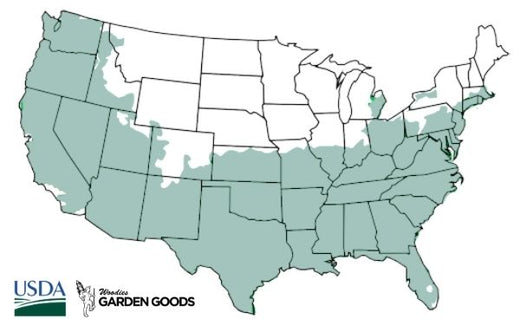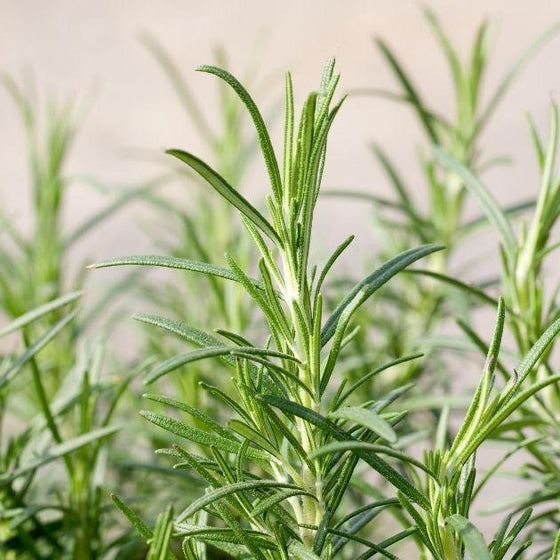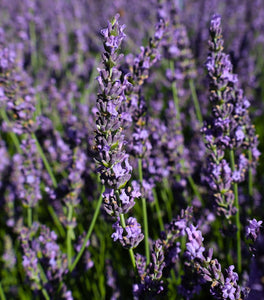
Images Depict Mature Plants
Rosemary Arp Plants
Rosemary ‘Arp’ (Rosmarinus officinalis 'Arp') is a cold-hardy, highly aromatic evergreen herb prized for its culinary versatility, ornamental value, and resilience in the landscape. Known for its upright growth habit and needle-like gray-green foliage, Rosemary Arp produces pale blue flowers from late winter through spring, attracting pollinators like bees and butterflies to the garden. This robust variety is one of the most cold-tolerant rosemarys available, thriving in USDA Zones 6–10 and making it a favorite for gardeners in cooler climates seeking year-round beauty and fresh herbs.
Ideal for herb gardens, raised beds, borders, and containers, Rosemary Arp adds structure, fragrance, and culinary usefulness to any setting. Its aromatic leaves can be harvested year-round and used fresh or dried in meats, breads, oils, and marinades, while its bushy form adds texture and color to the landscape. Drought-tolerant once established, this rosemary variety thrives in full sun and well-drained soil, making it an excellent choice for rock gardens, xeriscapes, or Mediterranean-style plantings. Its deer resistance and low-maintenance nature further enhance its garden appeal.
Rosemary Arp reaches 3 to 4 feet tall and wide, responding well to regular pruning, which promotes a denser shape and more flavorful foliage. Whether you’re planting it for its culinary benefits, fragrant foliage, or pollinator-friendly blooms, this hardy rosemary delivers dependable performance in both ornamental and edible gardens. With its superior cold tolerance and classic herbal aroma, Rosemary Arp is a must-have for gardeners who want beauty, function, and durability all in one plant.

| Hardiness Zone: | 6-10 |
|---|---|
| Mature Height: | 3 feet |
| Mature Width: | 2 to 3 feet |
| Sunlight: | Full Sun |
| Water Requirements: | Once established, water occasionally |
| Flower Color: | Purple |
| Usage: | Edible; Pet Friendly |
How to Care for Rosemary Arp
After purchasing your Rosemary Arp Plant, be sure to read our recommended care instructions to ensure a healthy and happy plant for years to come!
How Should I plant my Rosemary Arp Plants?
To plant your Rosemary Arp successfully, choose a location that receives full sun for at least 6 to 8 hours a day and has well-drained soil. This cold-hardy rosemary thrives in slightly alkaline to neutral soil with good air circulation around the plant. Begin by digging a hole twice as wide and the same depth as the root ball. Gently remove the plant from its container, loosen the roots, and place it in the hole so the top of the root ball is level with the surrounding soil. Backfill with native soil or a mix amended with sand or gravel to improve drainage, then water thoroughly to help the roots settle in. Once planted, apply a 2–3 inch layer of mulch—such as gravel or pine bark—around the base of the plant to conserve moisture and suppress weeds, keeping the mulch a few inches away from the main stem to prevent rot. Space multiple Rosemary Arp plants about 3 to 4 feet apart to allow for mature growth and good airflow. This variety is especially well-suited for raised beds, rock gardens, and container plantings, where soil drainage can be more easily controlled. With the right planting location and proper care, Rosemary Arp will establish quickly and provide fragrant, evergreen foliage and culinary benefits year-round.
How Do I Water My Rosemary Arp Plant?
Watering your Rosemary Arp plant correctly is essential for promoting healthy growth and preventing root rot, especially in its early stages. After planting, water deeply once or twice a week during the first growing season, allowing the soil to dry slightly between waterings. This encourages the development of a deep, drought-tolerant root system. Avoid overwatering or allowing the soil to remain soggy, as rosemary is highly sensitive to excess moisture and prefers dry, well-drained conditions. Once established, Rosemary Arp is exceptionally drought tolerant and typically requires minimal supplemental watering. In hot, dry climates or during extended periods without rain, a deep soak every two to three weeks is usually sufficient. Always check soil moisture before watering by inserting your finger a few inches into the soil—if it feels dry, it’s time to water. Whether grown in the ground or in containers, consistent but conservative watering helps Rosemary Arp thrive, maintaining its aromatic, evergreen foliage and supporting its resilience in herb gardens, rock gardens, and low-maintenance landscapes.
How do I Fertilize Rosemary Arp Plants?
Fertilizing your Rosemary Arp plant should be done sparingly, as this hardy herb thrives in lean, well-drained soil with minimal nutrient input. In early spring, apply a balanced, slow-release fertilizer such as a 10-10-10 formula to support healthy new growth as the plant emerges from winter dormancy. Scatter the fertilizer lightly around the drip line, keeping it several inches away from the base, and water it in thoroughly. Alternatively, organic options like compost or fish emulsion can be used to gently enrich the soil without encouraging overly lush, weak growth. Over-fertilizing Rosemary Arp can lead to reduced oil production in the foliage, which affects both its fragrance and culinary quality. In most cases, a single application per year is sufficient, especially if the plant is grown in nutrient-rich or amended soil. For container-grown rosemary, a diluted liquid fertilizer applied once every 4–6 weeks during the growing season may be beneficial. With modest feeding, Rosemary Arp will remain compact, flavorful, and robust, offering year-round beauty and herbal utility in gardens, raised beds, and decorative pots.

How and When Should I Prune My Rosemary Arp Plants?
Pruning your Rosemary Arp plants should be done in early spring, just after the last frost and before new growth begins in earnest. Begin by removing any dead, damaged, or woody stems to encourage healthy new growth and improve air circulation. Lightly shaping the plant at this time also helps maintain its compact, bushy form and prevents it from becoming leggy or sprawling. Use clean, sharp pruning shears and avoid cutting into old wood that lacks green growth, as rosemary does not regenerate well from bare stems. Throughout the growing season, you can continue to prune Rosemary Arp lightly by harvesting sprigs for culinary use. This ongoing, gentle trimming encourages branching and keeps the plant tidy and productive. Avoid heavy pruning in late fall, as this can stimulate new growth that may be damaged by cold weather. With regular, well-timed pruning, your Rosemary Arp will thrive as a fragrant, evergreen herb that offers both ornamental appeal and year-round culinary value in herb gardens, containers, and landscape borders.













